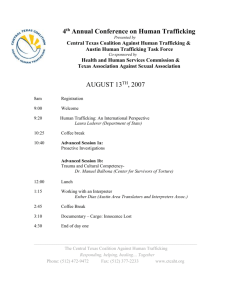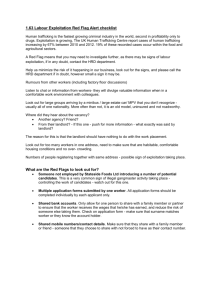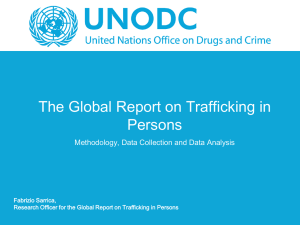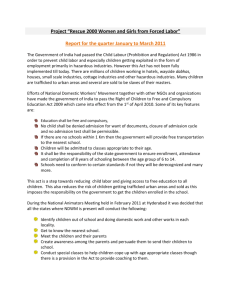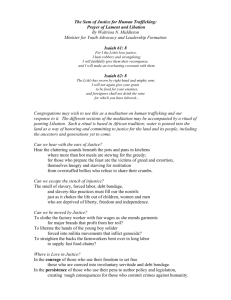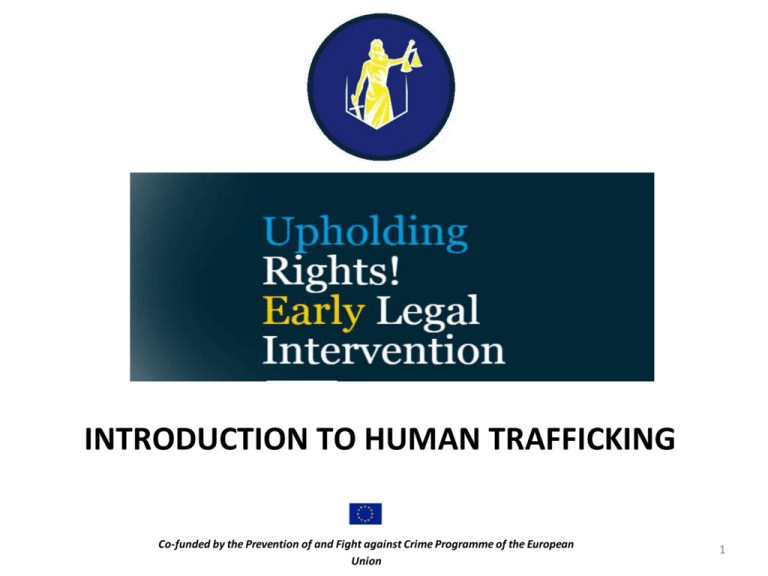
INTRODUCTION TO HUMAN TRAFFICKING
Co-funded by the Prevention of and Fight against Crime Programme of the European
Union
1
WHO WE ARE:
THE ELI
PROJECT
Upholding Rights!
Early Legal Intervention for Victims of Trafficking
The Early Legal Intervention [‘ELI’] pilots aim
to demonstrate the value and importance of
providing early and effective legal advice to
potential victims as soon as anyone recognises
them as such. This entails:
the provision of confidential advocacy at the
first encounter between victims and
authorities;
risk assessment of immediate protection
needs;
decision on the best/most appropriate route
for protection by State;
ensuring recovery and reflection (R&R) prior
to interviews; and
assessing criminalisation risks.
The key aim of the project is to impact on
national and EU anti-trafficking responses to
enhance the support and protection of
victims.
ELI project partners: Immigrant Council of
Ireland (Lead Partner), LSA Glasgow, AIRE
London, Centre for Women War Victims
2
Croatia, BGRF Bulgaria and KSPSC Lithuania.
STRUCTURE
1. What is trafficking?
2. Why does it happen?
3. What are the challenges in identifying victims
of trafficking?
4. What rights do victims have?
3
WHAT IS TRAFFICKING?
4
INTRODUCTIONS
Please introduce yourself telling us:
1. Your name
2. Your organisation
3. How trafficking is relevant to
your work
4. What you hope to learn
FILM
Satumaa – Wonderland
This film is a part of a social awareness campaign
against human trafficking in Finland. The track is
a rearrangement of a classic Finnish tango from
the 1950s. Satumaa tells about longing for a
better life somewhere over the ocean.
The film can be accessed online here https://vimeo.com/54754998
6
THE INTERNATIONAL LEGAL
FRAMEWORK
• Main framework set by the United Nations (UN) and
the International Labour Organisation (ILO).
• Relevant provisions can also be found in the UN
Convention of the Rights of the Child.
• Core instrument: The UN Protocol to Prevent, Suppress
and Punish Trafficking in Persons, Especially Women
and Children (the Palermo Protocol).
• Definition of trafficking widely adopted by the
international community.
7
COUNCIL OF EUROPE
The Council of Europe Convention on Action Against Trafficking in
Human Beings of 2005 (Human Trafficking Convention)
• Article 4: recruitment, transportation, transfer, harbouring or
receipt of persons, by means of the threat or use of force or other
forms of coercion, of abduction, of fraud, of deception, of the abuse
of power or of a position of vulnerability or of the giving or receiving
of payments or benefits to achieve the consent of a person having
control over another person, for the purpose of exploitation.
The European Convention of Human Rights (ECHR).
• Human trafficking is prohibited by Article 4 of this Convention which
also prohibits slavery, forced labour and servitude.
• Other rights protected by the ECHR may also be engaged when
looking at a state’s responsibilities to victims of human trafficking.
8
EU LAW
• Council Directive 2011/36/EU of 5 April 2011 on
preventing and combating trafficking in human beings and
protecting its victims (the Human Trafficking Directive).
– Extends the definition of human trafficking
– Sets state obligations to protect VoT
– Directly applicable and able to be relied upon if
transposed effectively into national legislation
• The EU Charter of Fundamental Rights
– Article 1: the principle of human dignity: any application
of EU law must have this principle at its core.
– Article 5 prohibits human trafficking
9
ARTICLE 2 OF EU DIRECTIVE
2011/36
Member States shall take the necessary measures to
ensure that the following intentional acts are punishable:
The recruitment, transportation, transfer,
harbouring or reception of persons, including the
exchange or transfer of control over those persons,
by means of the threat or use of force or other
forms of coercion, of abduction, of fraud, of
deception, of the abuse of power or of a position of
vulnerability or of the giving or receiving of
payments or benefits to achieve the consent of a
person having control over another person, for the
purpose of exploitation.
10
Children(ARTICLE 2)
• 5. When the conduct referred to in paragraph 1 involves a child, it
shall be a punishable offence of trafficking in human beings even
if none of the means set forth in paragraph 1 has been used.
• 6. For the purpose of this Directive, ‘child’ shall mean any person
below 18 years of age.
• As under Article 4 of the Council of
Europe Trafficking Convention;
Minors CANNOT consent to being
exploited, even in the absence of the
threat or use of force, or other forms
of coercion, deception, fraud etc.
11
IDENTIFICATION
Broad and universally accepted definition:
Adult victims:
Act
Means
Purpose
Child victims:
Act
Purpose
Note:
• No requirement for a transnational element.
• Means (for adults) include fraud, deception and abuse of
power or vulnerability.
12
• The purpose will broadly be exploitation.
CONSENT:PERSONS WITH
DISABILITIES
• Earning potential: a child with disabilities earns three times more
than a child without a disability in forced begging situations.
• In general, if a victim’s consent has been procured by means of
force, fraud, coercion, abuse of authority or abuse of vulnerability
(especially relevant in the case of mental disabilities), it will be
irrelevant.
• States must put in place additional supports for victims with special
needs such as disabilities or mental or psychological disorders
• Identification and in particular EARLY identification is key.
13
UN CONVENTION ON THE RIGHTS OF PERSONS WITH
DISABILITIES
• Article 11: “States Parties shall take, in accordance with their
obligations under international law, including international
humanitarian law and international human rights law, all necessary
measures to ensure the protection and safety of persons with
disabilities in situations of risk”. This could be helpful if trafficking
were to be interpreted as a situation of risk.
• Article 13 requires the Parties to ensure persons with disabilities
may access justice on an equal basis with others, including as
witnesses and at investigative stages. They must provide
appropriate training for working in the justice field, including police
and prison staff.
• Article 16(1): “States Parties shall take all appropriate legislative,
administrative, social, educational and other measures to protect
persons with disabilities, both within and outside the home, from all
forms of exploitation, violence and abuse, including their genderbased aspects.”
14
THE THREE ELEMENTS
15
THE NATIONAL DEFINITION
• Trainers should include information here
about their own country’s current definition of
trafficking.
• Trainers should highlight any differences
between national and European definitions.
• They should also highlight any problematic
issues with the definition within the national
context.
16
CASE STUDIES
Please read through the case studies and decide who is a
victim of trafficking and who is not
17
COMMON MISCONCEPTIONS
There does not
need to be an
international
element
• There does not need
to have been forced
movement, or
captivity of any kind
There does not
need to be sexual
exploitation
There does not
need to have
been violence
• Benefit fraud is
another form of
human trafficking
• Men and boys are
often victims of
trafficking
• But women and
children are more
vulnerable
• Or even the threat of
violence
• There does not have
to be slavery
The victims may
not know they
are being
trafficked
• They may even not
agree with the
finding that they are
VoT
• It doesn’t matter!
18
TRAFFICKING CRIMES
Sexual
Exploitation
i.e. Factories, fishing,
massage parlours, farms,
bars, hotels, restaurants
The pieces of
a puzzle that
can be
combined in
many ways
Domestic
slavery
Forced
Labour
Benefit Fraud
Sham
marriage
Forced
begging and
petty crime
Sexual Trafficking
is NOT the only
form of slavery!
Drug
cultivation
Trade in
human
organs
Petty crime
New forms of
exploitation
19
WHY DOES TRAFFICKING HAPPEN?
20
A SUCCESSFUL BUSINESS
THE
MARKET:
High
demand
Low
production
costs
Unique
selling
point
Low
competition
Good
service
Successful
business
High
Reward
Low risk
21
WHY IS TRAFFICKING A
LUCRATIVE BUSINESS
Trafficking is a big business driven by profit. Its main product has
some unusual features:
– Low freight costs: The victims move themselves
– Visible invisibility: Possession of a woman is not illegal per se!
– Enormously profitable:
• Worldwide profits estimate = $12 - $17 billion/ year. (ILO)
• $100,000/ year from one prostituted woman
• 100,000 EUR / year from one child in forced begging
– Sustainable source of income by their activities
– Low cost, low risk (high risk working conditions, higher working
hours)
– High return on investment
Remember: Traffickers behave like businessmen- they meet and adapt
to market demand.
22
TRAFFICKING: THE MARKET
DEMAND
Services:
Products:
i.e Cheap beauty
services, cheap
forced labour
i.e cheap clothes,
fruit, fish,
vegetables, drugs
Personal Subjugation:
i.e sexual services,
domestic slavery
23
DEMAND REDUCTION
Article 9(5) Palermo Protocol
‘State Parties shall adopt or strengthen legislative or other
measures, such as educational, social or cultural
measures, including through bilateral and multilateral
cooperation, to discourage the demand that fosters all
forms of exploitation of persons, especially women and
children, that leads to trafficking.’
A pull factor for trafficking for sexual exploitation is
the commodification of female bodies.
If we recognise that demand is indiscriminate and that
prostitution and trafficking for sexual exploitation are
intrinsically linked as interchangeable goods. With no
demand for sexual services there will be no market for
sexual services. This is the argument for the Swedish
model and making the purchase of sex illegal
EXAMPLE: CHEAP GOODS
European market’s demand for cheap Greek strawberries
Exploitation
Intent/ Purpose
Requires desperate Bangladeshi men willing to work tirelessly for a very low salary
Exploitation
Intent/ purpose
Requires transport of suitable men or creation of “incentives” for self- transportation
Transportation
Means
Requires coercion or deception of suitable men (ACT)
Leads to Ali being trafficked from Lesbos to Manolada (ACT)
25
WHAT ARE THE CHALLENGES IN
IDENTIFYING VICTIMS OF TRAFFICKING?
26
THE USE OF INDICATORS
• No full definition because trafficking is a complex
crime.
• Only few victims can identify themselves as VoT.
• Indicators contain a set of general and specific
situations.
• Indicators can be used as a handy reminder.
• Attention should be paid, lists are NOT exhaustive.
• Try to work backwards: focus on exploitation and not
on transportation.
27
INDICATORS:EXAMPLES
People who have been trafficked may:
• be distrustful or fearful of the authorities;
• act as if instructed by another or always escorted by another
• fear of saying what their immigration status is
• not be in possession of their passports or other documents
• not know their home or work address
• limited language ability
• physical indictors such as injuries or tattoos marking ownership
• psychological indicators such as fear, anxiety
28
EARLY INDICATORS
• At the moment, the vast majority of the indicators
are applicable once a person has come to seek
help in some way.
• But what if we had some indicators to assist the
professionals most likely to have a first hand
contact with a VoT?
i.e. a policeman arresting a minor in a
supermarket for petty theft
• What should they look out for?
• Majority of the indicators become visible too late
and are unhelpful for early identification.
EXAMPLES WHICH COULD
RAISE SUSPICION
•
•
•
•
•
•
•
•
•
•
Seasonal agricultural work
Shoplifting
Petty street crime
People washing windscreens at traffic lights
Advertisements for people looking for staff for care homes
Van depositing a number of people at a certain location
every day
A woman always showing up to medical appointments
accompanied by a “partner” who is supervising her
Model agencies
Tenants in a house who seem fearful
Any child begging should be considered to be a VoT/ at risk
of being a VoT
Can you think of other examples?
SELECTED ISSUES
A.
Early Identification/National Referral Mechanism
B.
Legal Rights and Responsibilities
C.
Missed opportunities case studies
D.
ELI revisited
31
A. EARLY IDENTIFICATION
32
THE LEGAL FRAMEWORK
Human Trafficking Convention – Article 10
• Each Party shall provide its competent authorities with
persons who are trained and qualified in preventing and
combating trafficking in human beings, in identifying and
helping victims, including children, and shall ensure that the
different authorities collaborate with each other as well as
with relevant support organisations, so that victims can be
identified in a procedure duly taking into account the special
situation of women and child victims.
EU Human Trafficking Directive – Article 11 (4)
• Member States shall take the necessary measures to
establish appropriate mechanisms aimed at the early
identification of, assistance to and support for victims, in
cooperation with relevant support organisations.
33
EARLY IDENTIFICATION OF VoT
• Early identification is the best way to ensure better
protection for the individual and key to a State
complying with its international obligations.
• Definition of NRM by OSCE: “A National Referral
Mechanism (NRM) is a co-operative framework through
which state actors fulfil their obligations to protect and
promote the human rights of trafficked persons, coordinating their efforts in a strategic partnership with
civil society."
• Each State has its own NRM procedures.
• Basic aims of NRMs:
– Ensuring human rights of VoT are respected
– Providing an effective way to refer VoTs to services 34
THE PROBLEM WITH NRMs
• Many countries have adopted identification mechanisms which are referred to
as NRMs but which vary in how closely aligned they actually are to the OSCE
principles.
• Many are law enforcement led which can limit the access that victims have to
the rights and protections they are entitled to under international law.
• Individual is not recognised as a victim unless that status has been formally
conferred on him or her through a formal framework such as an NRM.
• This is despite International and European legal standards being clear that
where an individual meets the definition of a victim of human trafficking, they
are to be recognised as a victim with all the rights and responsibilities that this
entails. Such rights do not stem from a formal status conferred on a victim but
from the victim’s experiences themselves and international law.
35
NATIONAL IDENTIFICATION
• Trainers should set out the system of
identification in your country.
• Discuss how closely it mirrors the OSCE models
and any problems in practice.
36
BARRIERS TO IDENTIFICATION
A barrier to disclosure is a reason why a trafficked person will resist disclosing
their situation to an interviewer.
A trafficked person may be reluctant to disclose information owing to:
1.
2.
3.
4.
5.
6.
7.
8.
Mistrust of others, shame and trauma.
Reluctant to repeat their story: re-traumatisation.
Fear of harm, and not realising that safe alternative options to their
situation exist.
Lack of understanding of trafficking, control, or their rights.
Manipulation by their trafficker.
Inability to discuss their trafficking experience due to their lack of life
experience i.e. when the victim is very young.
Debt bonding.
Lack of gender appropriate lawyers.
Note that some VOTs may have no idea that they have been trafficked
and/ or are unable/ unlikely to identify themselves as victims.
Disclosure may take a very long time.
37
THE INVISIBLE CHAINS: OTHER
BARRIERS
• Feelings of being
overwhelmed by their
situation, especially if they
are young
• Threats to their family
• Shame and other societal
barriers to speaking out
• Fear of what might
happen if they speak out,
including deportation and
a criminal record
• Language barriers if there
is no interpreter present
• Cultural/ religious beliefs
against speaking i.e.
Ritual oaths
• Deception and Drugging
• Convincing the victim
they are indebted to the
trafficker (Stockholm
syndrome)
• Fear of/ isolation from
the community
• Ensuring the victim does
not know that they have
been trafficked
Symptoms (not exhaustive): The VoT may be hyper alert to everything and/ or may present a
strong attachment to its trafficker(s).
Remember! These barriers to disclosure can be mitigated by an experienced, appropriate and
38
understanding interviewer.
Best practice in interviewing
suspected victims of trafficking
10 guiding principles in the World Health Organisation Ethical and
Safety Recommendations for Interviewing Trafficked Women:
1. Do no harm
2. Know your subject and assess the risks
3. Don’t offer advice or make promises that you cannot fulfil
4. Adequately select and prepare interpreters and co-workers
5. Ensure anonymity and confidentiality
6. Get informed consent
7. Listen to and respect each woman’s assessment of her situation and risks to her safety
8. Do not re-traumatise a woman
9. Be prepared for emergency information
10. Put information collected to good use.
Note that these principles are applicable to ALL VoTs
not just women, but also girls, boys and men.
+11. Help the VoT rebuild their power and regain control of her situation.
B. RIGHTS AND RESPONSIBILITIES
40
INTERNATIONAL OBLIGATIONS ON
MEMBER STATES
41
EU HUMAN TRAFFICKING
DIRECTIVE (2011/36/EC)
•
•
•
•
•
•
Recognises that human trafficking is a violation of fundamental rights
Recognises that trafficking is a gender-specific phenomenon
Recommends an integrated, holistic, human rights-based approach
Demands that a child’s best interests must be a primary consideration
Demands that attention to victims with special needs is required
States that existing international conventions on human trafficking should
be supported to avoid duplication of effort
• A broad concept of what should be considered trafficking is adopted by the
directive, including forced begging and trafficking for criminal activity
within its definition
• Infringement procedures are possible for a breach of its terms.
• Failure of a national court to make a reference to the CJEU (where
interpretation is not obvious) under Article 267 without any reasoning at
all is a breach of Article 6 ECHR.
42
THE COUNCIL OF EUROPE
PROTECTIVE SYSTEM
• CoE Human Trafficking Convention is the main tool
– Comprehensive framework for the identification,
protection and promotion of VOT rights.
• The European Convention on Human Rights (ECHR)
– Human trafficking, as defined within the Trafficking
Protocol and the Trafficking Convention is prohibited by
ECHR Art. 4
– Other ECHR rights may be triggered when looking at
state’s responsibilities to VoT i.e. Art. 3
– All public authorities must act in line with these rights.
– Powerful tool for victims’protection in terms of ensuring
full legal implementation of the state’s responsibilities
as well as obtaining damages for breach
– I.e. Siliadin v France, Rantsev v Cyprus and Russia
43
CoE CONVENTION
NON-LEGAL IMPLEMENTATIONS
• The Contracting Parties must take measures aimed at
prevention of trafficking, discouraging demand,
strengthening border controls to prevent trafficking, and
security, control, legitimacy and validity of documents.
• They must provide their competent authorities with persons
trained and qualified in combating trafficking, and take
appropriate measures regarding separated children.
• They must assist the recovery of the victims, including
providing adequate compensation.
• The Parties must co-operate internationally and with NGOs.
• The Convention does not affect the rights and obligations
derived from other international instruments.
44
CoE CONVENTION
LEGAL IMPLEMENTATIONS
• The Contracting Parties must introduce criminal
sanctions, including criminalising trafficking, use of
services of a victim of human trafficking, aiding and
abetting, and corporate sanctions.
• Victims must be able to make complaints before
competent authorities, and investigations must not be
dependent upon the report made by a victim.
• Measures must be taken to provide effective and
appropriate protection from retaliation or intimidation
of victims, those who report criminal offences,
witnesses, and the family members of each of the
parties.
45
THE CoE & EU
ADVOCACY AVENUES
•
•
•
•
Council of Europe
Informing GRETA about failures in the domestic
systems
Ensuring that an Art 13 ECHR effective remedy
exists
Consider the possibility of taking both the country
of origin and the host country to the ECtHR ( see
Rantsev v Russia and Cyprus)
Pose questions to responsible states about what
kind of actions they are taking to comply with
their international and European obligations
46
THE CoE & EU
ADVOCACY AVENUES
•
•
•
•
•
The European Union
Early notification to the Commission of failures to
properly transpose or to comply with the Human
Trafficking Directive
Followed up as appropriate with a view to infringement
proceedings
NGOs seeking at an early stage to intervene in any
domestic proceedings with a view to a reference being
made to the Court of Justice of the European Union
(under Art 267 of the Treaty of Functioning of EU)
Encouraging national courts to refer appropriate cases
to the CJEU
Be aware of the jurisprudence on failure to refer to the
CJEU (Ferreira da Silva case)
47
RIGHTS OF TRAFFICKING VICTIMS
48
RIGHTS OF VoTS: THE GENERAL
FRAMEWORK
Access to compensation
(including legal aid for
this purpose )
Protection from
secondary victimisation
Access to support and
assistance
Access to restitution
including restoration of
liberty
Access to information on
available remedies in a
language the victim
understands
Access to free legal
assistance and legal aid
without delay for the
length any civil, criminal
or other action against
the perpetrators
Access to support and
facilitation to
rehabilitation
49
OBSTACLES TO CLAIMING RIGHTS
Unclear role distribution
amongst stakeholders or lack of
trained staff members in
frontline services
Culture of mistrust in
identification and credibility
assessment
Obstacles to
advocacy
Lack of early access to legal aid
or long procedures
Racism, prejudices and
stereotyping against women in
forced prostitution and/or
victims of forced begging
NON-PROSECUTION and NONPUNISHMENT
Article 8 of Human Trafficking Directive 2011/36:
Non-prosecution or non-application of penalties to the
victim:
Member States shall, in accordance with the
basic principles of their legal systems, take the
necessary measures to ensure that competent
national authorities are entitled not to
prosecute or impose penalties on victims of
trafficking in human beings for their
involvement in criminal activities which they
have been compelled to commit as a direct
consequence of being subjected to any of the
acts referred to in Article 2.
51
ARTICLE 8 DIRECTIVE 2011/36/EU
It is notable that:
• it is analogous with Article 26 of the CoE
Trafficking Convention, but it introduces the
concept of non-prosecution;
• it still doesn’t amount to a defence in law –
leaving victims with defence of duress (or a
guilty plea); and
• unlike Article 2 of the Directive, it does not
distinguish between adults and minors.
52
FOCUS ON CHILDREN
• International law recognises that children have particular needs and
require additional protections and rights which it provides,
• This makes the identification of child victims of trafficking crucial.
– Age Assessment
• In case of uncertainty about the age of the trafficked person,
he or she should be presumed to be a child in order to
receive immediate assistance, support and protection
– Guardian/Representative
• There is a requirement that a child be provided with a
guardian or representative, from the moment a child is
identified by the authorities, in a situation where the
parents cannot represent the child because of a conflict of
interest between them, or because they are absent.
53
FOCUS ON CHILDREN
• Guardian/Representative cont’d
– One should be appointed, where appropriate, for separated children.
• Individual Assessments
– Trafficking Directive requires individual assessments of the
circumstances of each child victim to be carried out taking into
account the child’s needs and concerns with a view to finding a
durable solution.
• Specific assistance, support and protection to child victims of human
trafficking who are defined as being under the age of 18.
54
RIGHT TO COMPENSATION
• Compensation mechanisms exist in most European states but for a variety
of reasons, only a minority of victims receive the compensation they are
entitled to.
• Access to compensation is one of the weakest protected rights and often
most inaccessible.
• This is despite its role in combatting trafficking which is restorative,
punitive and preventative.
– Restorative – can assist with recovery and empower an individual to
move on with lives.
– Punitive – taking money from trafficker has a direct
effect/punishment.
– Prevention – strong deterrent mechanism.
55
COMPENSATION-THE LEGAL
FRAMEWORK
Palermo Protocol - States must ensure that at least one type of legal procedure is available to
trafficked persons to access compensation.
Human Trafficking Convention – strengthens right to access compensation from the trafficker
and provides right to access state compensation.
EU Human Trafficking Directive 2011/36/EU, Article 17.Victims are entitled to access existing
compensation schemes for victims of violent intentional crimes.
EU Directive 2004/80/EC relating to compensation to crime victims
•
Requirement to establish state scheme for victims of violent crime and set up a system
for facilitating compensation for victims of violence crime in cross border situations.
EU Directive 2012/29/EU on establishing minimum standards on rights, support and
protection of victims of crime
•
Article 16 - right to a decision on compensation from the offender in the course of
criminal proceedings/measures to encourage offenders to provide adequate
compensation to victims.
•
Article 4 - right to receive information from the first contact with competent state
authorities on compensation.
Articles 4 (prohibition on forced labour) and 13 (right to an effective remedy) ECHR work
together to demand compensation for VoT.
56
C. MISSED OPPORTUNITIES
57
MISSED OPPORTUNITIES:
CASE STUDIES
Please read through the case studies
and discuss how ELI could have made a
difference to the outcome.
58
CASE STUDY (UK)
R v O [2008] EWCA Crim 2835: ‘the common
law and Article 6 of the European Convention
on Human Rights alike require far higher
standards of procedural protection than were
given here. There was no fair trial...’
Prosecutors and Defence lawyers are ‘to make
proper enquiries’.
59
D. EARLY LEGAL INTERVENTION
60
MAIN PRINCIPLES OF ELI
•
•
•
•
•
Partner relationships and co-working
(ensure that agency responsibilities are
clear, roles are formalised and that
memoranda of understanding are
introduced)
Obtaining Evidence to support the
client’s case
Holistic approach
Tenacity
Frontloading
61
EARLY LEGAL INTERVENTION:
THE BENEFITS
For VoT:
•
•
•
•
•
•
Access to rights
Avenue to recovery
Non-punishment
Compensation
Reducing the risk of re-victimisation
EARLY intervention= EARLY, TIMELY
resolution of the problem, focus on
the goal/aim of the procedure
For the work of organisations:
•
•
•
•
•
Development of appropriate support
and care plans meeting the client
needs
Effective legal representation and
speedier resolution
Increase of possibility of victim
cooperation with the police- better
witnesses in criminal prosecutions of
traffickers- successful prosecutions
Enhanced coordination between
agencies
Rights of VoT are upheld by the state
and all statutory agencies involved->
reduced risk for future claims against
the state and/ or negative
international evaluations.
62
GROUP EXERCISE
• How can ELI apply more widely in your country?
• How can ELI develop to offer more in your country?
• Further advocacy and cooperation ideas on national and
European level.
63
ENDS
Slavery was abolished 150 years ago and
yet there are more people in slavery
today than at any other time in our
history…….
64




